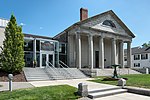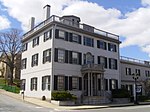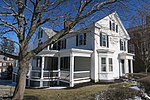Plymouth Antiquarian House
Federal architecture in MassachusettsHistoric house museums in MassachusettsHouses completed in 1809Houses in Plymouth, MassachusettsHouses on the National Register of Historic Places in Plymouth County, Massachusetts ... and 4 more
Massachusetts museum stubsMuseums in Plymouth, MassachusettsNational Register of Historic Places in Plymouth County, MassachusettsPlymouth County, Massachusetts Registered Historic Place stubs

The Plymouth Antiquarian House (also known as Hedge House or "Hammatt House") is an historic house museum in Plymouth, Massachusetts owned by the Plymouth Antiquarian Society. The house was built in 1809 for William Hammatt, a New England sea captain. The Hedges, a family of entrepreneurs, purchased the house in 1830 and lived there until 1919. The house was originally located on Court Street but was moved to Water Street by the Antiquarian Society in 1919. It is open during the summer months. The house was added to the National Register of Historic Places in 1974.
Excerpt from the Wikipedia article Plymouth Antiquarian House (License: CC BY-SA 3.0, Authors, Images).Plymouth Antiquarian House
Memorial Drive, Plymouth
Geographical coordinates (GPS) Address Nearby Places Show on map
Geographical coordinates (GPS)
| Latitude | Longitude |
|---|---|
| N 41.960277777778 ° | E -70.667777777778 ° |
Address
Memorial Drive 10
02360 Plymouth
Massachusetts, United States
Open on Google Maps











